The Tommore Burn smolt trap will be familiar to Spey followers. The Tommore Burn is a lower tributary of the River Avon (A’an), which it joins a short distance upstream of the Delnashaugh Hotel. This burn has an impassable culvert under the Glenlivet Road so it has been stocked since 2012 with salmon from our hatchery. From 2013 the stocked 0+ parr have been fin-clipped to aid identification and since 2015 the Tommore trap has been operated to count the smolts emigrating in the spring. In addition we have completed a number of electrofishing surveys each summer to assess the parr population. The video below shows the trap on a snowy spring morning.
DSCF6517 from Spey Foundation on Vimeo.
In the summer of 2017 the parr population in the sample sites was approximately double the density seen in previous years so an increased smolt production was anticipated in 2018.
The graphs below shows the Tommore trap salmon smolt count to date, the upper graph showing water level and the lower the water temperature.
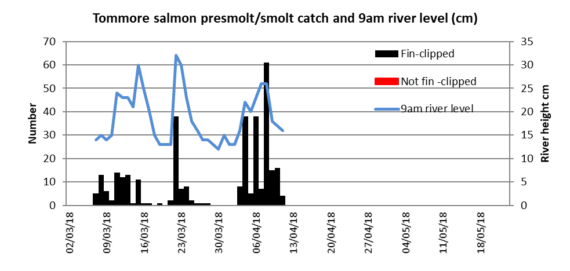
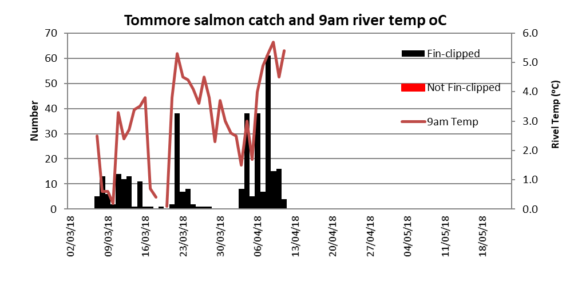
There has been no shortage of water so far this spring, mainly from snow melt on Ben Rinnes, although the snow pack there is running out. At the same time the water temperatures have been low, a consequence of the long drawn out winter. The total catch of salmon smolts so far this year is 332, although they have been mainly presmolts. This compares with 234 at the same date in 2015, the year with the highest total so far (382). It has been cooler this year, the mean temperature over equivalent periods being 3.7oC in 2018 and 4.55oC in 2015. Trap operation commenced at an earlier date this year but the count is still ahead of 2015 on a like for like basis.
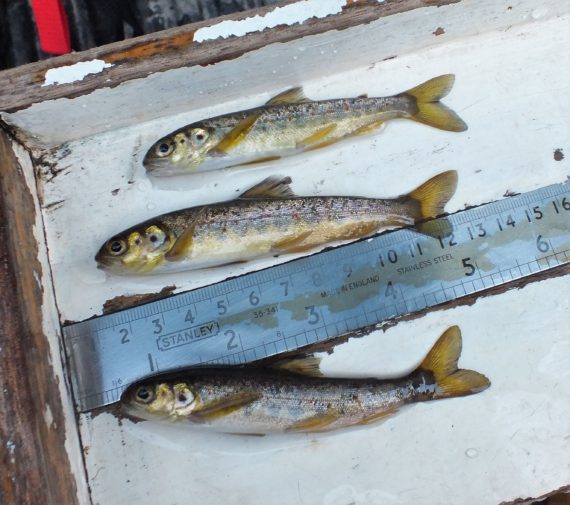
Assuming there is some rainfall in the next week or two the 2018 smolt count from the Tommore is on schedule to be the highest to date but each year is different. One finding from the Tommore Burn research has been that the smolts leave the Tommore much earlier than they start to move in the larger tributaries, this may be in response to the greater need to migrate when there is water in the small burns.
The broodstock for the Tommore Burn fish were taken from the Avon mainstem, mainly in 2015, although there appears to be an increased proportion of larger, three year old smolts this year. We don’t know where these fish would ultimately have spawned if they had been left to their own devices but it is unlikely they were all destined to spawn in small burns. If that is the case, this early emigration behaviour observed may be an instinctive trait.
It is interesting to reflect on the potential contribution of the Tommore Burn to the Spey. If 500 smolts emigrate from the Tommore Burn this year, and they all survive to reach the sea, the maximum number of returning fish that could be expected is 25 (at 5% marine survival). This may produce a rod catch of 4 fish (15% exploitation). This is less than 0.08% of the relatively poor Spey salmon catch in 2017.
Another way of assessing the Tommore Burn is to look at the number of broodstock used. The Tommore smolts are mainly 2 year olds, therefore the 2018 smolt run is from the 2016 stocking/2015 broodstock. In 2015 13 hens were taken from the Avon and 58% of the resulting 0+ parr were stocked in the Tommore. This equates to 8 hens and 8 cock salmon, 16 in total therefore contributing to the Tommore stocking. There are a lot of assumptions made here but the number of returning adults could be higher than the number of broodstock used (25 compared to 16). This is not the massive multiplier effect that may be expected, in fact it looks quite modest. Such modest gains have to be considered against the negative impacts arising from stocking (see CNL_17_40_KyleYoung).
Further updates on the Tommore Burn will be provided as the season progresses. More frequent updates are made on the Spey Fishery Board Facebook page.

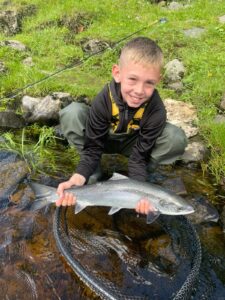

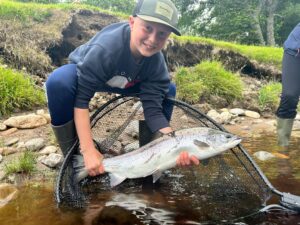


7 thoughts on “Tommore trap update”
Hi Brian.
Having read this Kyle Young’s findings,maybe we ought to point out to him the sucess of the ghillie led Tomore burn project, which I’m sure you must agree has been a great achievement led by Steve Brand, especially when we consider it was said by some cynical doubters that all those parr would die within a week of planting out.
What are your thoughts on Mr Young’s juvenile movement idea?
Has this been trailed on any other Scottish salmon river?
If you went round the beats on the Spey I would doubt very much if you would find any ghillie or owner who would agree to having a percentage of their juvenile fish relocated even if they were in the fortunate position to have an excess.
Hi Dougie,
Good to hear from you and apologies for taking so long to reply.
Maybe you should re-read the Kyle Young paper as he concluded that even stocking with first generation wild fish had an impact on native stocks. I do agree that the Tommore Burn has been an interesting project, it is good to be able to piece all the elements of a stocking programme together in this way. The current tally for 2018 is now over 400, so this will be the highest smolt emigration to date from the burn.
I like the concept of fry translocation, although we will have to test how practicable it is. There has been some similar work done elsewhere in Scotland but it was never written up or published, as far as I am aware. However I am sure that we could find suitable locations for a trial, and that permission could be secured from all parties. I think the point is that there will be an excess of fry in many parts of the river during the period after emergence, however the trial will provide some of the answers we all seek. Like you I am sure that everyone would not want to endanger the existing native stocks.
Regards
Brian
Hi Brian, how are the smolt numbers from the traps this year. Thanks.
Hi Euan, Apologies, I was on holiday last week but have caught up with the smolt traps now. So far we have caught 529 fin-clipped smolts in the Tommore Burn, the highest total since stocking and trapping commenced. There were no fish in the Tommore trap today, I think the run is over there now.
In the Dulnain the run continues with 268 salmon smolts today, the total is now around 2850 so far. We will calculate capture efficiency at the end but we are probably catching 1 in 6 of the run. The smolts are late this year and very silvery now.
346 salmon smolts have been caught n the Fiddich trap so far, more than last year (248) but again we will need to calculate the capture efficiency. At present it looks like we are catching 4 out of 10 salmon smolts passing. Good big smolts in the Fiddich this year (the trap is in the headwaters); as in the Dulnain they are very silvery now.
I had two reports today from lower river ghillies about smolts with fungus in the gills, lets hope this is not as bad as last year.
Regards
Brian
Brian, I would be very interested to know how accurate your capture efficiency predictions are. Having witnessed the rotary screw traps in operation on the mainstem I feel that numbers are being pulled out of the air.
What I can tell you, although I understand it is anecdotal is there are very few juvenile fish on Arndilly. We have caught 1 smolt this week and it was fin clipped.
Regards, Euan.
Hi Euan, we operate the smolt traps and capture efficiency models according to the American Fisheries Society protocols http://www.iucn.stateofthesalmon.org/fieldprotocols/downloads/SFPH_p8.pdf. There is an extensive section on assessing trap efficiency and estimating the total run. We take this very seriously. In the Dulnain ten mark-recapture trials have been completed so far, the results ranging from zero to 26%. Theses trials were conducted during a range of flows but a critical analysis will be done before the results are published. The actual number of fish captured in the Dulnain is now higher than last year but we need to wait to see how the efficiency trials conclude.
The smolt run, from the eastern side of the catchment, at least, will be down this year. 2018 will be the year when the two year old smolts from the 2016 cohort will be leaving (Storm Frank impacts on redds). However there are still smolts about, good quality fish too. The fry counts were good last summer were the best seen in recent years so I was anticipating good parr counts this summer, I hope I am right. Fin-clipped smolts form a small percentage of the total output, it was good to hear of one being caught.
Regards, Brian
Any more updates to the 2018 smolt trap data ?